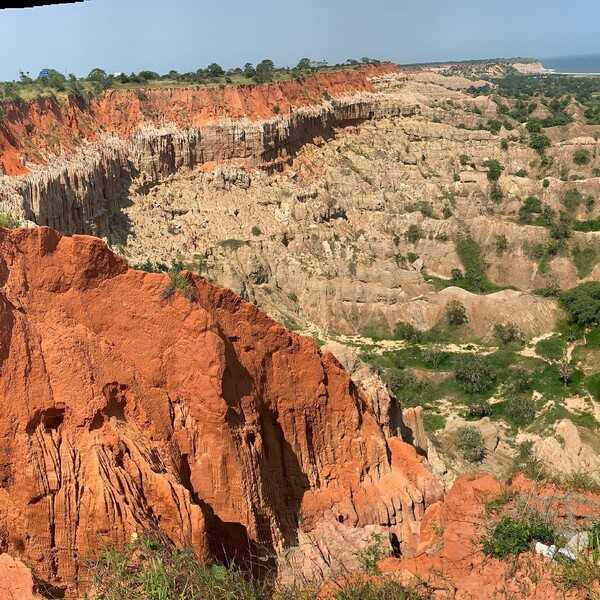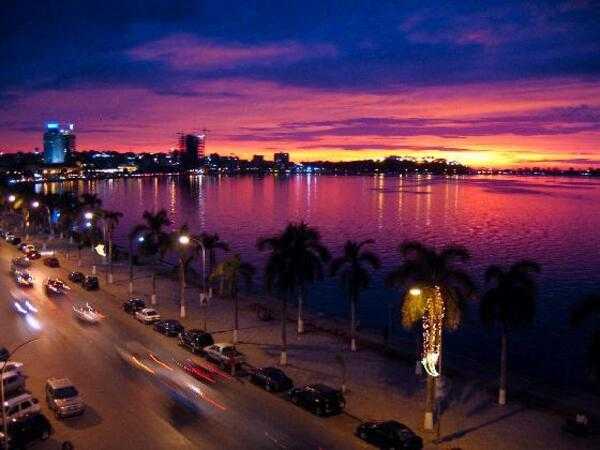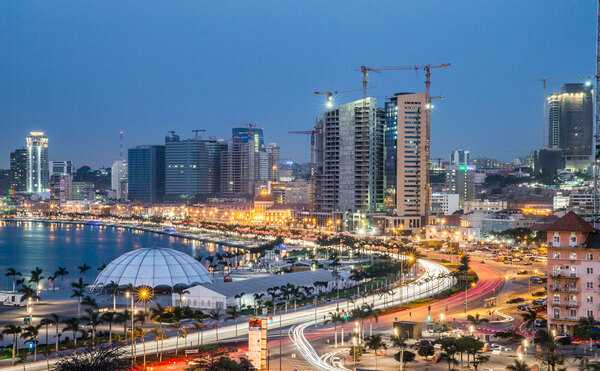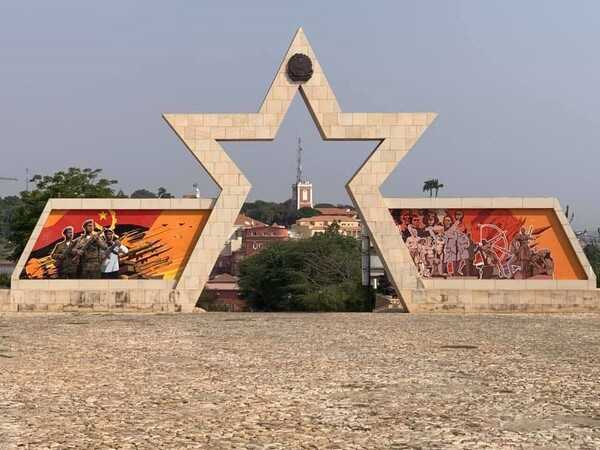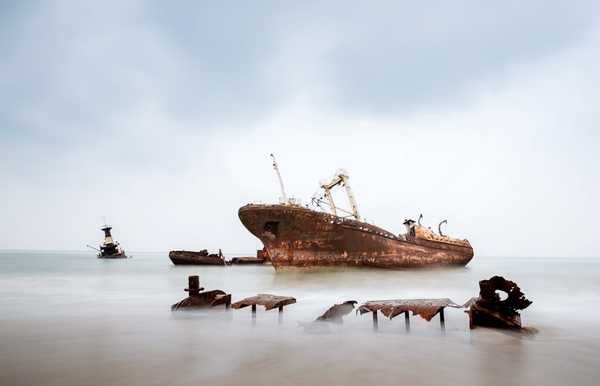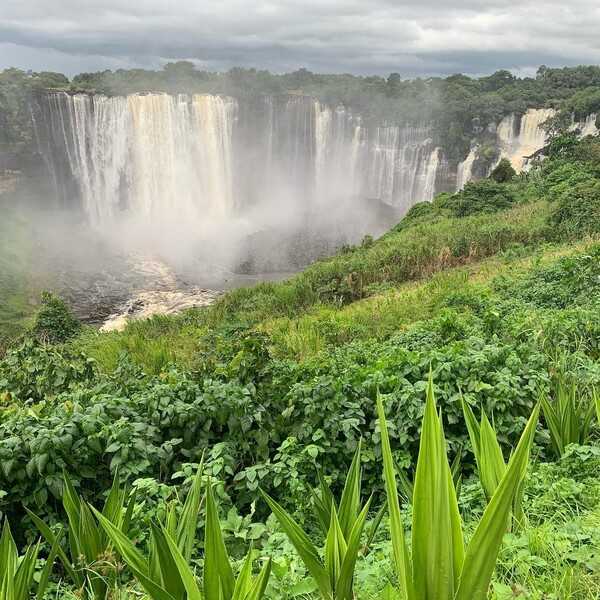Angola - AO - AGO - ANG - Africa
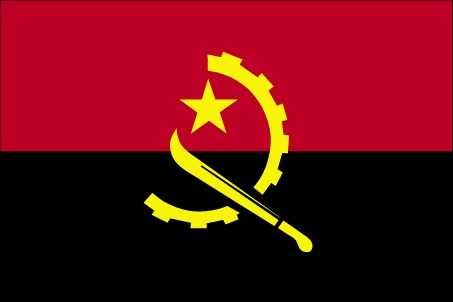
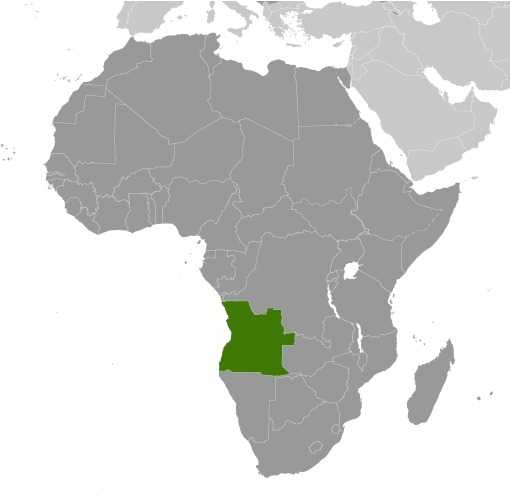
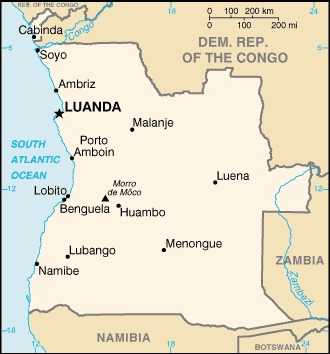
Angola Images
Angola Factbook Data
Diplomatic representation from the US
embassy: Rua Houari Boumedienne, #32, Luanda
mailing address: 2550 Luanda Place, Washington, DC 20521-2550
telephone: [244] (222) 64-1000
FAX: [244] (222) 64-1000
email address and website:
Consularluanda@state.gov
https://ao.usembassy.gov/
Age structure
15-64 years: 50.7% (male 9,076,080/female 9,795,035)
65 years and over: 2.4% (2024 est.) (male 367,559/female 509,546)
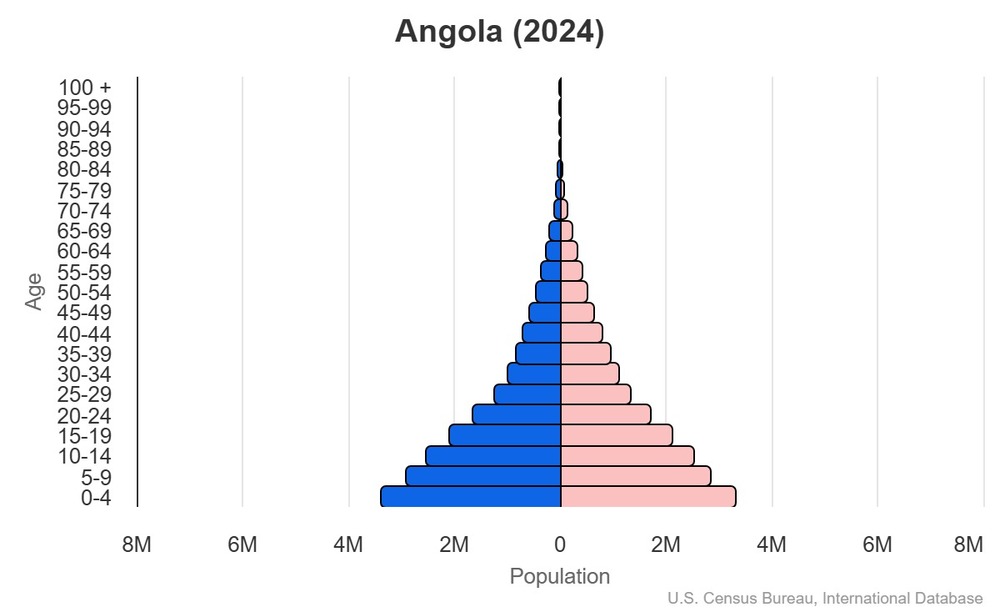
For additional information, please see the entry for Population pyramid on the Definitions and Notes page.
Geographic coordinates
Sex ratio
0-14 years: 1.01 male(s)/female
15-64 years: 0.93 male(s)/female
65 years and over: 0.72 male(s)/female
total population: 0.96 male(s)/female (2024 est.)
Natural hazards
Area - comparative
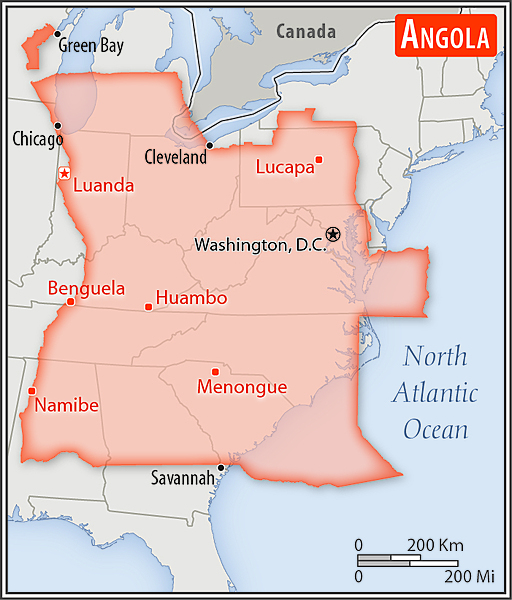
about eight times the size of Georgia; slightly less than twice the size of Texas
Background
The Angolan National Revolution began in 1961, and in 1975, Angola won its independence when Portugal’s dictatorship fell, a collapse that occurred in part because of growing discontent over conflict in Angola and other colonies. Angola’s multiple independence movements soon clashed, with the Popular Movement for Liberation of Angola (MPLA), led by Agostinho NETO, taking power and the National Union for the Total Independence of Angola (UNITA), led by Jonas SAVIMBI, emerging as its main competitor. After NETO’s death in 1979, Jose Eduardo DOS SANTOS, also of the MPLA, became president. Over time, the Angolan civil war escalated and became a major Cold War conflict, with the Soviet Union and Cuba supporting the MPLA and the US and South Africa supporting UNITA. Up to 1.5 million lives may have been lost -- and 4 million people displaced -- during the more than a quarter-century of fighting. SAVIMBI's death in 2002 ended UNITA's insurgency and cemented the MPLA's hold on power. DOS SANTOS did not seek reelection in 2017 and supported Joao LOURENCO’s successful bid to become president. LOURENCO was reelected in 2022. Angola scores low on human development indexes despite using its large oil reserves to rebuild since 2002.
Environmental issues
International environmental agreements
signed, but not ratified: none of the selected agreements
Population below poverty line
note: % of population with income below national poverty line
Household income or consumption by percentage share
highest 10%: 39.6% (2018 est.)
note: % share of income accruing to lowest and highest 10% of population
Exports - commodities
note: top five export commodities based on value in dollars
Exports - partners
note: top five export partners based on percentage share of exports
Administrative divisions
Agricultural products
note: top ten agricultural products based on tonnage
Military and security forces
Ministry of Interior: National Police, Border Guard Police (2025)
Budget
expenditures: $13.871 billion (2019 est.)
note: central government revenues and expenses (excluding grants/extrabudgetary units/social security funds) converted to US dollars at average official exchange rate for year indicated
Capital
geographic coordinates: 8 50 S, 13 13 E
time difference: UTC+1 (6 hours ahead of Washington, DC, during Standard Time)
daylight saving time: does not observe daylight savings time
etymology: the Portuguese named the city São Paulo da Assunção de Loanda (Saint Paul of the Assumption of Loanda); over time, it was shortened to "Luanda," which may derive from a Bantu word meaning "tax" or "duty," in reference to local people paying their dues to the king of the Congo
Imports - commodities
note: top five import commodities based on value in dollars
Climate
Coastline
Constitution
amendment process: proposed by the president of the republic or supported by at least one third of the National Assembly membership; passage requires at least two-thirds majority vote of the Assembly subject to prior Constitutional Court review if requested by the president of the republic
Exchange rates
Exchange rates:
869.846 (2024 est.)
685.02 (2023 est.)
460.568 (2022 est.)
631.442 (2021 est.)
578.259 (2020 est.)
Executive branch
head of government: President Joao Manuel Goncalves LOURENCO (since 26 September 2017)
cabinet: Council of Ministers appointed by the president
election/appointment process: the candidate of the winning party or coalition in the last legislative election becomes the president; president serves a 5-year term (eligible for a second consecutive or discontinuous term)
most recent election date: 24 August 2022
election results: Joao Manuel Goncalves LOURENCO (MPLA) elected president by then winning party following the 24 August 2022 general election
expected date of next election: 2027
Flag
meaning: red stands for liberty and black for the African continent; the emblem symbolizes workers and peasants
Independence
Industries
Judicial branch
judge selection and term of office: Supreme Court judges appointed by the president on recommendation of the Supreme Judicial Council, an 18-member body chaired by the president; judge tenure NA; Constitutional Court judges - 4 nominated by the president, 4 elected by National Assembly, 2 elected by Supreme National Council, 1 elected by competitive submission of curricula; judges serve single 7-year terms
subordinate courts: provincial and municipal courts
Land boundaries
border countries (4): Democratic Republic of the Congo 2,646 km (of which 225 km is the boundary of discontiguous Cabinda Province); Republic of the Congo 231 km; Namibia 1,427 km; Zambia 1,065 km
Legal system
Legislative branch
legislative structure: unicameral
number of seats: 220 (all directly elected)
electoral system: proportional representation
scope of elections: full renewal
term in office: 5 years
most recent election date: 8/24/2022
parties elected and seats per party: Popular Movement for the Liberation of Angola (MPLA) (124); National Union for the Total Independence of Angola (UNITA) (90); Other (6)
percentage of women in chamber: 39.1%
expected date of next election: August 2027
Literacy
male: 83.8% (2015 est.)
female: 51.9% (2015 est.)
Maritime claims
contiguous zone: 24 nm
exclusive economic zone: 200 nm
International organization participation
National holiday
Nationality
adjective: Angolan
Natural resources
Geography - note
Economic overview
Political parties
Humanist Party of Angola or PHI
National Front for the Liberation of Angola or FNLA; note - party has two factions
National Union for the Total Independence of Angola or UNITA (largest opposition party)
Popular Movement for the Liberation of Angola or MPLA; note- ruling party in power since 1975
Social Renewal Party or PRS
Railways
narrow gauge: 2,638 km (2022) 1.067-m gauge
123 km 0.600-mm gauge
Suffrage
Terrain
Government type
Country name
conventional short form: Angola
local long form: Republica de Angola
local short form: Angola
former: People's Republic of Angola
etymology: in the 15th century, Portuguese explorers derived the name from the title "N'gola," which was held by kings of the Ndongo
Location
Map references
Irrigated land
Diplomatic representation in the US
chancery: 2108 16th Street NW, Washington, DC 20009
telephone: [1] (202) 785-1156
FAX: [1] (202) 822-9049
email address and website:
info@angola.org
https://angola.org/
consulate(s) general: Houston, New York
Internet users
Internet country code
Refugees and internally displaced persons
IDPs: 75,308 (2024 est.)
GDP (official exchange rate)
note: data in current dollars at official exchange rate
Total renewable water resources
Urbanization
rate of urbanization: 4.04% annual rate of change (2020-25 est.)
Broadcast media
Drinking water source
urban: 71.7% of population (2022 est.)
rural: 27.8% of population (2022 est.)
total: 57.7% of population (2022 est.)
unimproved:
urban: 28.3% of population (2022 est.)
rural: 72.2% of population (2022 est.)
total: 42.3% of population (2022 est.)
National anthem(s)
lyrics/music: Manuel Rui Alves MONTEIRO/Rui Alberto Vieira Dias MINGAO
history: adopted 1975
Major urban areas - population
International law organization participation
Physician density
National symbol(s)
Mother's mean age at first birth
note: data represents median age at first birth among women 20-49
GDP - composition, by end use
government consumption: 6.3% (2024 est.)
investment in fixed capital: 25% (2024 est.)
investment in inventories: 0% (2024 est.)
exports of goods and services: 37.9% (2024 est.)
imports of goods and services: -24.4% (2024 est.)
note: figures may not total 100% due to rounding or gaps in data collection
Dependency ratios
youth dependency ratio: 91.1 (2024 est.)
elderly dependency ratio: 5.1 (2024 est.)
potential support ratio: 19.8 (2024 est.)
Citizenship
citizenship by descent only: at least one parent must be a citizen of Angola
dual citizenship recognized: no
residency requirement for naturalization: 10 years
Population distribution
Electricity access
electrification - urban areas: 76.2%
electrification - rural areas: 7.3% (2018 est.)
Civil aircraft registration country code prefix
Sanitation facility access
urban: 93.7% of population (2022 est.)
rural: 30.3% of population (2022 est.)
total: 73.5% of population (2022 est.)
unimproved:
urban: 6.3% of population (2022 est.)
rural: 69.7% of population (2022 est.)
total: 26.5% of population (2022 est.)
Ethnic groups
Religions
Languages
note: shares sum to more than 100% because some respondents gave more than one answer on the census
Imports - partners
note: top five import partners based on percentage share of imports
Elevation
lowest point: Atlantic Ocean 0 m
mean elevation: 1,112 m
Health expenditure
6.7% of national budget (2022 est.)
Military - note
Hospital bed density
Total water withdrawal
industrial: 239.6 million cubic meters (2022 est.)
agricultural: 146.7 million cubic meters (2022 est.)
Waste and recycling
percent of municipal solid waste recycled: 19% (2022 est.)
Average household expenditures
on alcohol and tobacco: 1.4% of household expenditures (2023 est.)
Major aquifers
National heritage
selected World Heritage Site locales: Mbanza-Kongo
Major watersheds (area sq km)
Indian Ocean drainage: Zambezi (1,332,412 sq km)
Internal (endorheic basin) drainage: Okavango Basin (863,866 sq km)
Major rivers (by length in km)
note: [s] after country name indicates river source; [m] after country name indicates river mouth
Child marriage
women married by age 18: 30.3% (2016)
men married by age 18: 6% (2016)
Petroleum
refined petroleum consumption: 121,000 bbl/day (2023 est.)
crude oil estimated reserves: 7.783 billion barrels (2021 est.)
Natural gas
consumption: 1.244 billion cubic meters (2023 est.)
exports: 4.928 billion cubic meters (2023 est.)
proven reserves: 343.002 billion cubic meters (2021 est.)
Coal
Electricity generation sources
solar: 2.2% of total installed capacity (2023 est.)
hydroelectricity: 74% of total installed capacity (2023 est.)
biomass and waste: 0.3% of total installed capacity (2023 est.)
Gross reproduction rate
Remittances
0% of GDP (2023 est.)
0% of GDP (2022 est.)
note: personal transfers and compensation between resident and non-resident individuals/households/entities
Space agency/agencies
Ports
large: 0
medium: 0
small: 8
very small: 13
ports with oil terminals: 17
key ports: Cabinda, Estrela Oil Field, Lobito, Luanda, Malongo Oil Terminal, Namibe, Palanca Terminal, Takula Terminal
National color(s)
Particulate matter emissions
Methane emissions
agriculture: 374.5 kt (2019-2021 est.)
waste: 123 kt (2019-2021 est.)
other: 78.5 kt (2019-2021 est.)
Labor force
note: number of people ages 15 or older who are employed or seeking work
Youth unemployment rate (ages 15-24)
male: 30.2% (2024 est.)
female: 25.7% (2024 est.)
note: % of labor force ages 15-24 seeking employment
Net migration rate
Median age
male: 15.8 years
female: 16.8 years
Debt - external
note: present value of external debt in current US dollars
Maternal mortality ratio
Reserves of foreign exchange and gold
$13.942 billion (2023 est.)
$13.655 billion (2022 est.)
note: holdings of gold (year-end prices)/foreign exchange/special drawing rights in current dollars
Total fertility rate
Unemployment rate
14.6% (2023 est.)
14.7% (2022 est.)
note: % of labor force seeking employment
Population
male: 18,196,058
female: 19,006,003
Carbon dioxide emissions
from coal and metallurgical coke: 9,000 metric tonnes of CO2 (2023 est.)
from petroleum and other liquids: 17.21 million metric tonnes of CO2 (2023 est.)
from consumed natural gas: 2.441 million metric tonnes of CO2 (2023 est.)
Area
land: 1,246,700 sq km
water: 0 sq km
Taxes and other revenues
note: central government tax revenue as a % of GDP
Real GDP (purchasing power parity)
$266.452 billion (2023 est.)
$263.61 billion (2022 est.)
note: data in 2021 dollars
Airports
Infant mortality rate
male: 60.7 deaths/1,000 live births
female: 50.3 deaths/1,000 live births
Telephones - mobile cellular
subscriptions per 100 inhabitants: 67 (2022 est.)
Gini Index coefficient - distribution of family income
note: index (0-100) of income distribution; higher values represent greater inequality
Inflation rate (consumer prices)
13.6% (2023 est.)
21.4% (2022 est.)
note: annual % change based on consumer prices
Current account balance
$4.185 billion (2023 est.)
$11.763 billion (2022 est.)
note: balance of payments - net trade and primary/secondary income in current dollars
Real GDP per capita
$7,300 (2023 est.)
$7,400 (2022 est.)
note: data in 2021 dollars
Broadband - fixed subscriptions
subscriptions per 100 inhabitants: (2023 est.) less than 1
Obesity - adult prevalence rate
Energy consumption per capita
Death rate
Birth rate
Electricity
consumption: 16.214 billion kWh (2023 est.)
transmission/distribution losses: 1.725 billion kWh (2023 est.)
Merchant marine
by type: general cargo 13, oil tanker 8, other 43
Imports
$23.688 billion (2023 est.)
$28.564 billion (2022 est.)
note: balance of payments - imports of goods and services in current dollars
Exports
$36.961 billion (2023 est.)
$50.12 billion (2022 est.)
note: balance of payments - exports of goods and services in current dollars
Heliports
Telephones - fixed lines
subscriptions per 100 inhabitants: (2023 est.) less than 1
Alcohol consumption per capita
beer: 3.78 liters of pure alcohol (2019 est.)
wine: 0.72 liters of pure alcohol (2019 est.)
spirits: 1.27 liters of pure alcohol (2019 est.)
other alcohols: 0.08 liters of pure alcohol (2019 est.)
Life expectancy at birth
male: 60.8 years
female: 65.1 years
Real GDP growth rate
1.1% (2023 est.)
3% (2022 est.)
note: annual GDP % growth based on constant local currency
Industrial production growth rate
note: annual % change in industrial value added based on constant local currency
GDP - composition, by sector of origin
industry: 44.2% (2024 est.)
services: 39.3% (2024 est.)
note: figures may not total 100% due to non-allocated consumption not captured in sector-reported data
Population growth rate
Land use
arable land: 4.3% (2023 est.)
permanent crops: 0.3% (2023 est.)
permanent pasture: 32.4% (2023 est.)
forest: 51.6% (2023 est.)
other: 11.5% (2023 est.)
Space program overview
Military service age and obligation
Military expenditures
1.2% of GDP (2023 est.)
1.2% of GDP (2022 est.)
1.4% of GDP (2021 est.)
1.5% of GDP (2020 est.)
Military and security service personnel strengths
Military equipment inventories and acquisitions
Currently married women (ages 15-49)
Key space-program milestones
2022 - second communications satellite (AngoSat-2) with French-built payload, integrated and launched by Russia
2023 - signed US-led Artemis Accords outlining best practices for space exploration
2024 - inaugurated a national maritime coordination and surveillance center and country's first satellite mission control center
2025 - signed financial agreement with France for construction of country’s first high-resolution remote sensing satellite (ANGEO-1)
Education expenditure
6.5% national budget (2025 est.)
